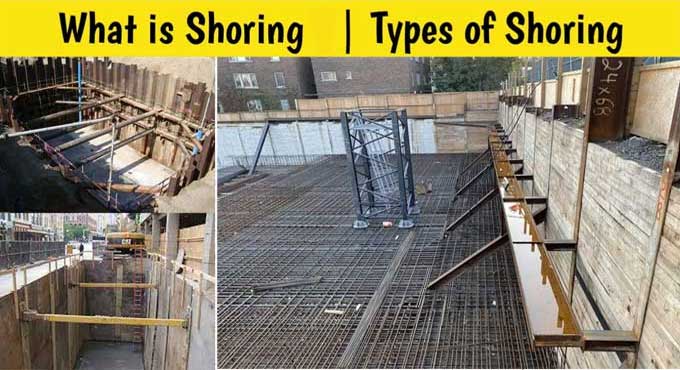NEWS | SOFTWARE | SHEET
Everything you need to know about Shoring in Construction
Shoring is the process of supporting a structure temporarily to prevent collapse or failure during construction or repair work. Shoring is an essential part of construction projects involving excavation, underpinning, or propping up existing structures. Different types of shoring systems are used depending on the situation and soil conditions.
Uses of Shoring in Construction
Shoring is used in construction for various purposes:
- Supporting excavations - When excavating for basements, foundations, or utility trenches, the sides of the excavation need support to prevent collapse. Shoring systems such as sheet piles, soldier piles and lagging, or trench boxes are used.
- Underpinning existing foundations - When repairing or extending existing foundations, shoring is used to support the structure above while the work is performed. This prevents settlement and damage.
- Propping up existing structures - Shoring can be used to temporarily support parts of structures being repaired or modified to allow work to proceed safely.
- Preventing lateral movement - Shoring systems like tiebacks and soil nails can be used to prevent lateral movement of the soil and stabilize slopes.
Types of Shoring Used in Construction
There are several common types of shoring systems used in construction:
- Sheet Piles - Steel or wood panels are driven into the ground to form a continuous wall that supports the sides of the excavation. Sheet piles are used for shallow excavations in stable soil.
- Soldier Piles and Lagging - Vertical steel beams (soldier piles) are installed in the ground, and horizontal wood or steel planks (lagging) are placed between the piles. This is used for deeper excavations in stable soil.
- Trench Boxes - Prefabricated steel boxes that are lowered into the excavation to support the sides. Used for utility trenches and narrow excavations.
- Shoring Frames - Wood or steel frames that are braced and installed to support structures. Used for underpinning and propping.
- Tiebacks - Steel rods anchored into the soil behind the shoring system. Used to resist lateral forces and stabilize slopes.
- Soil Nails - Steel rods grouted into the soil to reinforce it. Similar to tiebacks but used for stabilizing slopes and excavations in unstable soil.
Advantages of Shoring
- Provides support and stability during construction to ensure safety of workers.
- Prevents damage to existing structures from settlement or movement.
- Can be designed for different soil conditions and load requirements.
- Reusable - shoring systems can often be dismantled and reused on other projects.
Disadvantages of Shoring
- Installation can be time-consuming and labour-intensive.
- Requires skilled workers to design and install properly.
- Costs can be high depending on the shoring system and depth of excavation.
- Some systems are permanent and cannot be reused.
Factors Affecting Shoring Design
Several factors affect the design and selection of a shoring system:
- Soil type and condition - Clay, sand, and gravel soils require different shoring systems. Stable or unstable soil affects shoring needs.
- Depth of excavation - Deeper excavations require stronger, more robust shoring systems. The depth of the excavation influences the type and complexity of the shoring system required. Deeper excavations may necessitate more robust and extensive shoring techniques.
- Expected loads - The weight of soil, adjacent structures, and any surcharge loads determine the strength of shoring needed.
- Time excavation will be open - Longer time periods require more durable shoring that can withstand weathering.
- Space constraints - Some shoring systems require more room for installation than others.
- Cost - Different shoring systems have varying material and installation costs.
The General Process of Shoring
The general process for installing shoring involves determining shoring needs based on the factors above. The appropriate system is selected - sheet piles, soldier piles, etc. The system is designed based on load requirements and soil conditions. The shoring is installed by driving piles, assembling frames, and so on. Excavation then occurs with the shoring in place to support the sides. The shoring system is monitored during construction for changes. Finally, the shoring is removed or disassembled once it is no longer needed.
To get more details, go through the following video tutorial.
Lecturer: Amazing Engineering | ACES
The general brief process for installing shoring systems is as follows:
- Determining shoring needs based on the factors above.
- Selecting the appropriate shoring system - sheet piles, soldier piles, etc.
- Designing the system based on load requirements and soil conditions.
- Installing the shoring system - driving piles, installing frames, etc.
- Excavating with the shoring in place to support the sides.
- Monitoring the shoring system during construction for changes in load or soil.
- Removing or disassembling the shoring once it is no longer needed.
Shoring plays a crucial role in ensuring the safety and stability of construction projects, particularly during excavation and structural installation. By understanding the different types of shoring, their uses, advantages, disadvantages, and the factors involved, construction professionals can select and implement appropriate shoring systems.
While shoring adds to the project costs and requires careful planning, its benefits, such as enhanced safety, structural stability, and adaptability, outweigh the disadvantages. By adhering to best practices and conducting regular monitoring, shoring can effectively support excavation and construction activities, facilitating the successful completion of projects while prioritizing safety and integrity.


